Injera – Quick and easy spongy, crepe-like flatbread that’s slightly sour, slightly sweet, and utterly addictive.

I remember a time in my life, (my broke and ignorant college days) when I be-grudgingly ate injera, at least once a week. You see, I had this Ethiopian roommate that could not have a meal without Injera. Why the HECK would anyone pick sour spongy bread over fresh Baguette? Sadly, at that time, I did not get it.
And to add salt to injury, 9/10 times when it was her turn to pick out a place, to eat, it would be at an Ethiopian restaurant. I just couldn’t bring myself to say no, she was really sweet. It was one of those things that kept her going. So I kept it civil and accepted politely. Yes, after eating it so many times, it quickly grew on me.
To this date; I crave it and make a stop at my favorite Ethiopian restaurant to pick up a plate of food with Injera. The funny thing is, my family doesn’t get it either. Fyi, they are a lost cause. So never attempted to make one at home until now.
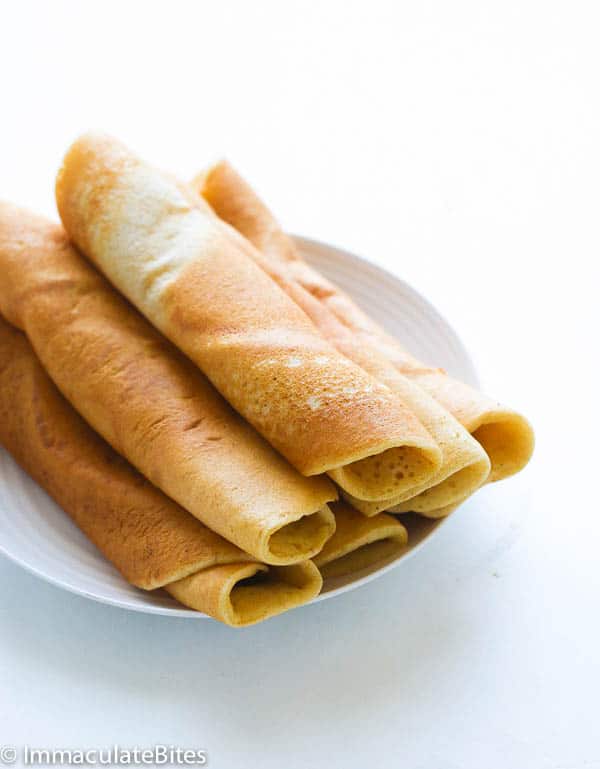
What is injera?
Injera is a Flat round fermented sourdough bread- bread like no other, with a unique, slightly spongy texture. Always present during mealtime, in countries like Ethiopia, Eritrea, Somalia, Yemen, Djibouti and Sudan with each country having its own variation.
What is injera made of?
Different variants of this dish use different mixes of ingredients. For my very own Immaculatebites version, I used the following ingredients:
- Corn flour – Made from finely ground dried corn.
- Sorghum – An ingredient native to Africa. its usually used to make cereals and alcoholic beverages. You can use whole wheat in place of this ingredient.
- Sugar – Common table sugar you can easily find in any grocery store.
- Dry Yeast – This ingredient helps make our dish light and airy. Use warm water to activate it.
- Warm Water – An essential part of making any dough. It’s the basis for forming our treat. This activates the yeast. Use the right warmth to activate the yeast.
- All Purpose Flour – This pantry must-have isn’t just for baking. it’s also great for many savory dishes.
- Baking Powder – An instant ingredient that helps our dough rise. it’s basically sodium bicarbonate. it reacts well with acid.
- Salt to taste
I am not going to lie, making authentic Ethiopian injera, with Teff flour is no Joke and not for the faint of heart. I tried several variations. Comparing it to restaurant quality injera. But it’s just too tedious and involved, even for a seasoned cook.
Recipe Variation
At one point, I could just picture the look on my sister’s face, and the words coming out of her mouth. “So expect me to make this! No thanks.” Quickly decided against it- for now. One of these days am going back to it.
I settled for this Somalia Version, instead (known as canjeero or lahooh) somewhat similar in taste to injera, fairly easy and better tasting than some of the Injera’s I tried making at home. Good enough to be an edible plate and sturdy enough to scoop up stews.
This right here, is a great introduction into the world of sour dough spongy flatbread and ANYONE can make it-Scout’s Honor. And you don’t need a special pan for this-just make sure it’s a non-stick pan. For those that enjoy the sour taste you can let it ferment after 2 hours and then refrigerate overnight. The flavor intensifies and renders the dough sour.
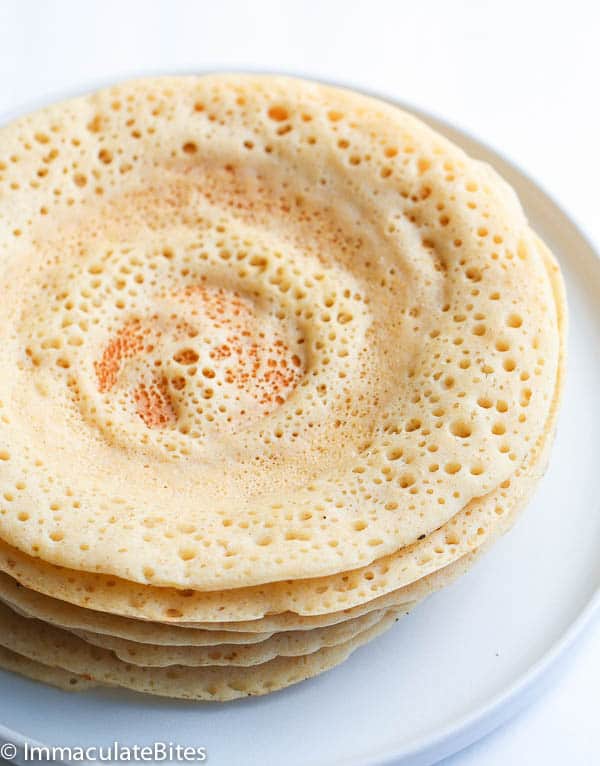
I adapted this Injera from this lovely couple here, they share Amazing Somalia recipes- do check them out if you want to learn how to make more delicious Somalia recipes. And also got a few hints here
This might not be authentic Ethiopian injera but it’s good enough to make again and again, and it’s even got a thumbs up from hubby.
What to eat with Injera?
An added bonus is that you can sweetened things up with cinnamon sugar, honey and this spiced butter here . Then enjoy as a breakfast item, snack, or dessert. Believe me, you are not going to want to stop.
A Great flatbread to have on hand when making Doro Wat. BOY! the two eaten together DIVINE! Get the recipe for Doro Wat Ethiopian Chicken Stew.
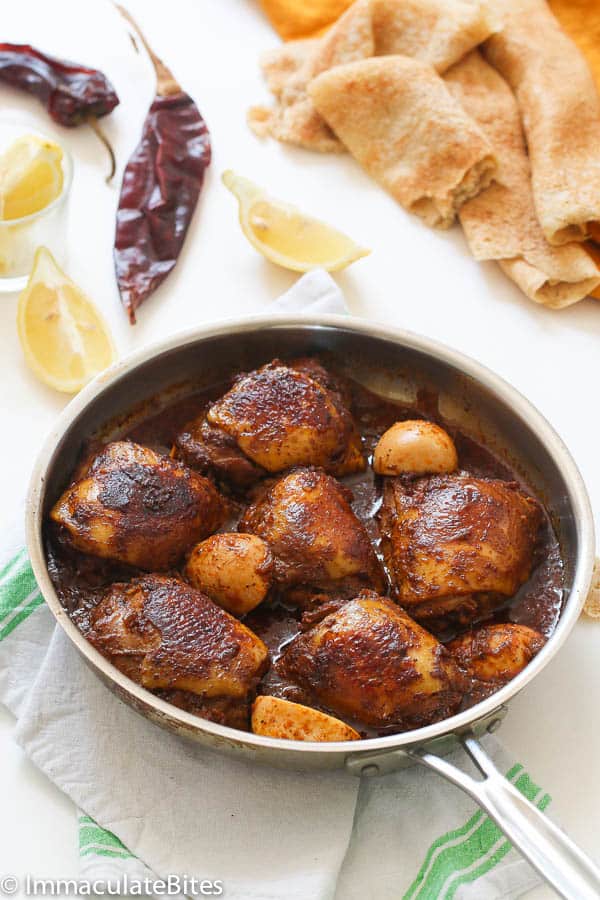
Tips and Tricks
- Make by hand for smooth batter – Is preferable to make injera by hand , so you get a feel of the batter. Start by adding a cup of water at a time to make a smooth batter.
- Flour Substitute – Traditionally this injera is made with sorghum flour. However, you may substitute the sorghum flour with whole wheat flour. Barley flour works as well.
- Humidity Consideration – Keep in mind that humidity, flour and water do play a role in making this injera.Injera should be thicker than a crêpe, but not as thick as a traditional American pancake.
- Self Rising Flour Replacement – You may replace the flour , salt and baking powder with the same amount of self rising flour as it’s customary.
How to make Injera?
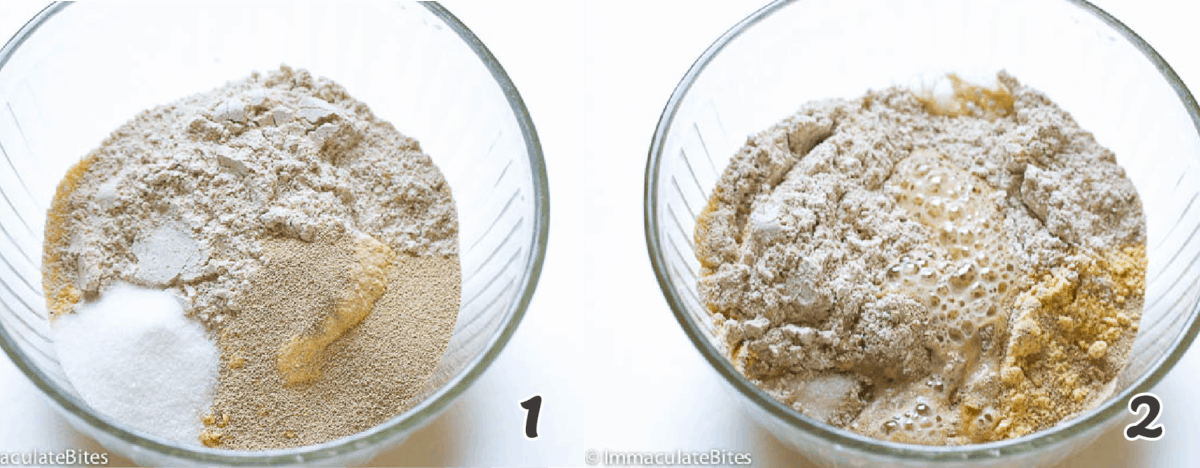
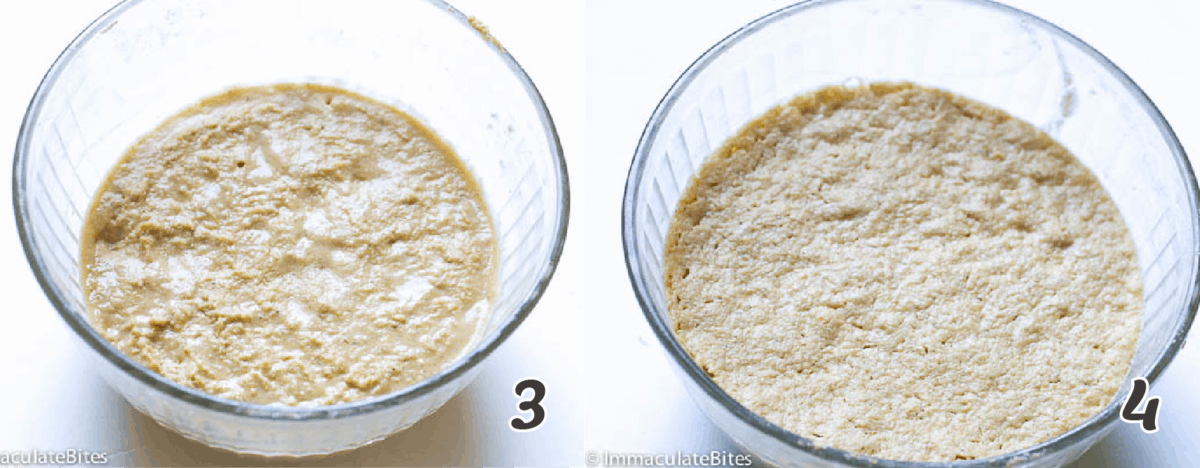
- Combine corn flour, sorghum, sugar, yeast, and water. Mix and let it rise (See photos 1-4)
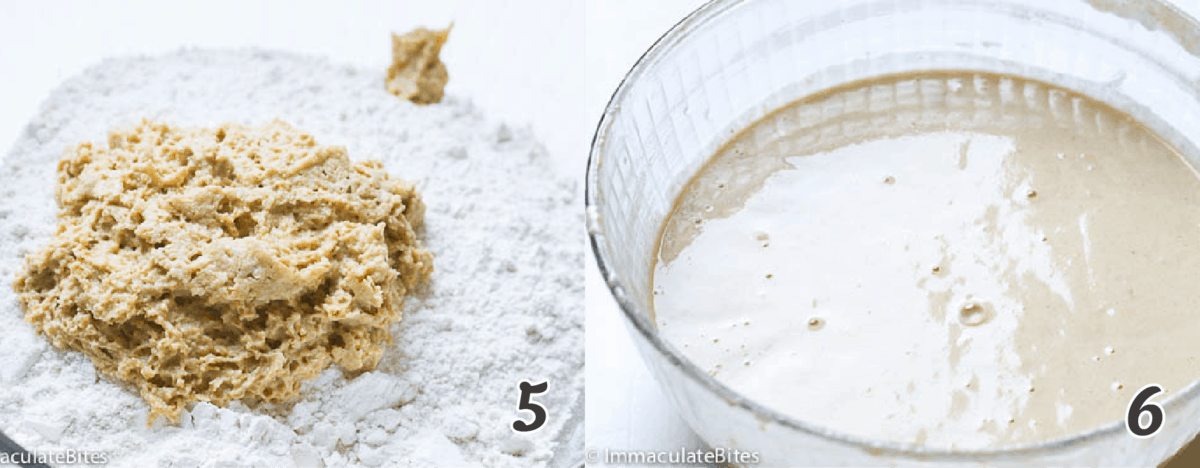
- In another large bowl, combine flour, salt, and baking powder and sugar
- Add the starter mixture to the flour mixture. Thoroughly mix and start adding water a little at a time until water has completely been used up, thoroughly mix to eliminate any lumps. You may use a blender to aid the process (See photos 5-6)
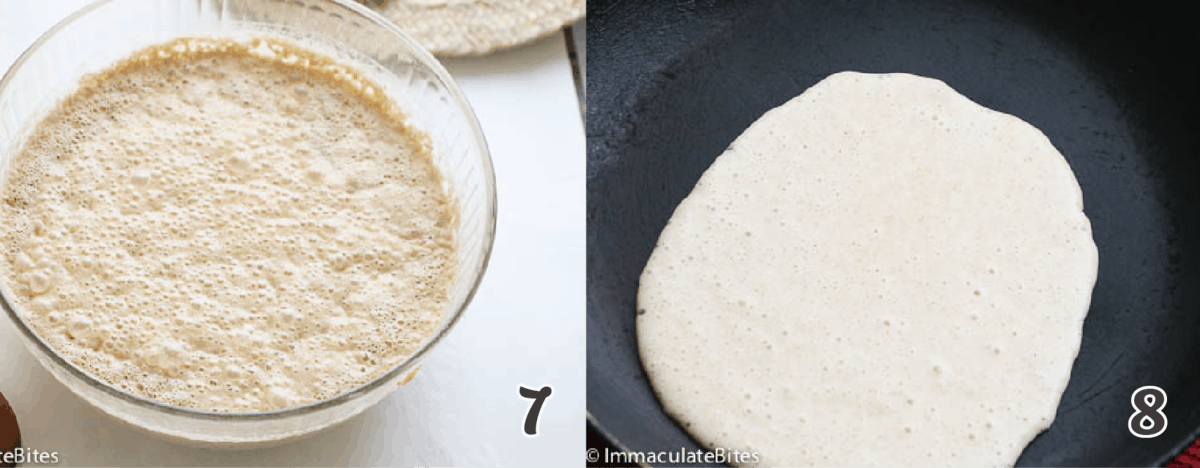
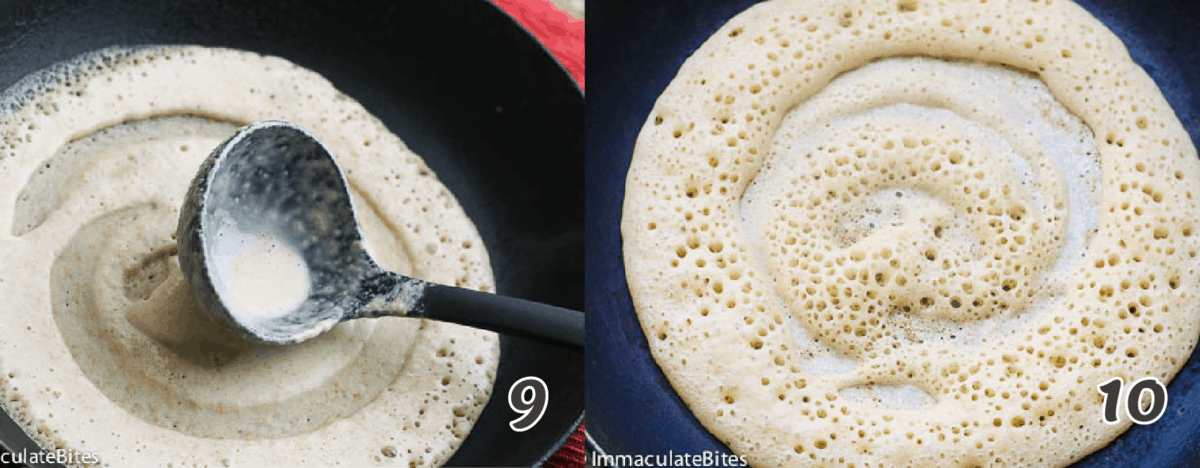
- Let it rise for about 2 hours (See photo 7)
- Heat a skillet, crepe pan, or non-stick fry pan preferably one with matching lid to medium high heat.
- When ready to cook, pour a ladleful (about 3/4 cup or more) of injera batter. Spread in a circular motion about the size of a dinner plate. Covering it with the lid shortens the cooking time. (See photo 8-9)
- Let it cook until all batter forms little brown spots coming through. No need to turn the batter. (See photo 10)
- Transfer to a plate with a spatula. put aside and continue cooking until you use up all the batter.
Injera
Ingredients
Starter
- 1 cup corn flour
- 1/2 cup sorghum or whole wheat
- 1 Tablespoon sugar
- 1 Tablespoon dry yeast
- 1 1/4 cup warm water
- 4 cups all purpose flour
- 6 teaspoons baking powder
- 4 teaspoons salt
- ¼ cup sugar
- 4 cups warm water
Instructions
Starter Method
- Combine corn flour , sorghum or whole wheat , sugar yeast and water , mix and let it rise for about an hour.
- In Large bowl combine flour , salt, baking powder and sugar
- Add the starter mixture to the flour, thoroughly mix and start adding water a little at a time until water has been completely used up, thoroughly miss to eliminate any lumps. You may use the blender to aid in the process.
- Let it rise for about 2 hours
Quick Method
- In a large bowl combine all the ingredients, then start by adding a cup of water at a time to prevent lumps, then mix with hands preferably.
- Continue adding water, one cup at a time water until the water is completely used up.
Blender Method
- Add water followed by the rest of the ingredients pulse until ingredients are fully blended
- Remove place in a large bowl and loosely cover with kitchen, let it rise for about 2 hours until bubbles form.
- Heat up a skillet, crepe pan, or non-stick fry pan preferably one with a matching lid.
- Heat the skillet on medium high heat, and then when ready to cook pour a ladleful (about ¾ cup or more) of the injera batter on to the pan spread from the center in a circular motion. About the size of a dinner plate. You may cover if you have a matching lid, covering shortens the cook time otherwise let it cook until all batter forms little brown spots coming through. No need to turn the batter.
- Transfer to a plate with a spatula or plate, put aside and continue cooking until the batter is finished
Tips & Notes:
- Is preferable to make injera by hand, so you get a feel of the batter. Start by adding a cup of water at a time to make a smooth batter.
- Traditionally this injera is made with sorghum flour. However, you may substitute the sorghum flour with whole wheat flour. Barley flour works as well.
- Keep in mind that humidity, flour and water do play a role in making this injera.Injera should be thicker than a crêpe, but not as thick as a traditional American pancake.
- You may replace the flour , salt and baking powder with the same amount of self rising flour as it’s customary.
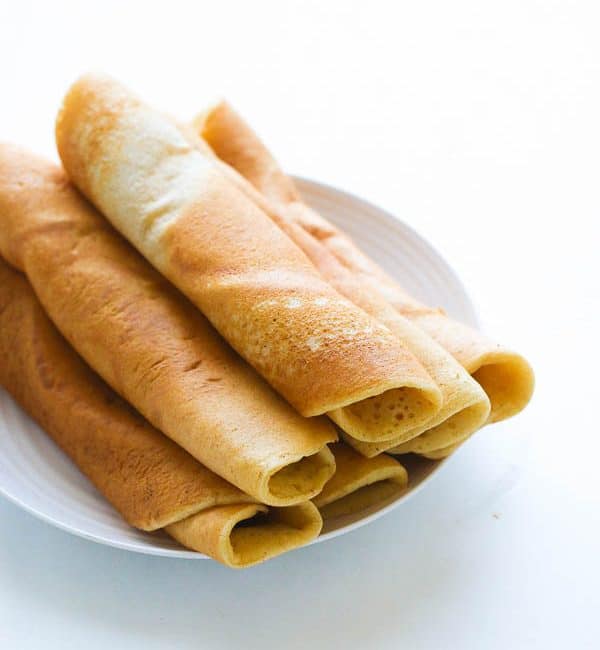
Jim C. says
This recipe is fantastic. I use teff flour for the starter.
Imma says
Oh great to hear that. Thank you so much!
Diane says
Love the soft texture. Yes, it’s not injera, more like a thin, velvety soft English crumpet. Very nice for soaking up sauces and curries. Delicious.
Imma says
Thank you so much, Diane. Stay tuned and enjoy more recipes:)
kobuu says
I made this and they were tasty but my husband didn’t like them as Injera replacement. But, this is listed as non-traditional so I get that. The batter will make tasty pancakes for sure or you can use the “injera” as a pancake/base for other stuff (like strawberry jam!).
Allen Mitchell says
Can you give this recipe using baking soda instead of baking powder and yeast. Baking powder has aluminum in it. It is not good for the body. Also your body can not get rid of it.
Elizabeth bain says
I made the bread using the quick method. I divided the recipie in thirds.
There are two of us. I made the bread once with Teff flour and the fermentation that makes it sour. We did not like it. We liked your bread and, even though not authentic, prefer it. Goes well with my Moroccan
Food as well. Great website. Thank you.
ImmaculateBites says
Yayy! Nice! Glad you liked it!
Sarah from Sweden says
Hi there, could i skip out on the corn flour and just use all wheat flour?
Immaculate Bites says
Hi Sarah! You may use wheat flour as a substitute just keep in mind that you would need around double of wheat flour vs corn flour and that it may also affect the taste. 🙂 Let me know how it turns out!
Anonymous says
I appreciate that you were trying to make a quick version of injera, but this is not authentic by any means. You skipped out on the most important ingredient that makes injera what it really is, teff flour. This is a crepe. This is not injera and should not be called injera.
Immaculate Bites says
Hi! As mentioned, this is not authentic and just my own take also based on another recipe 🙂 Thank you for your comment, I appreciate it.
Asha says
I am in love with this bread! Thanks for linking to the Xawaash website as well, as that is awesome and provided visibility into Somali cuisine which you don’t see or hear much about. I’ve made this bread twice already, but I only used 1.5 tsp salt and 1 heaped tsp of baking powder. Great with saucy savory dishes, and equally delicious with a little butter and sugar or sweetened condensed coconut milk. So glad I found this- thanks!!
Immaculate Bites says
Thank you, Asha!
Jim says
I have made this several times using the long method and sorghum flour. It works perfectly and I am making it again tonight.
Any suggestions how to make it gluten free?
ImmaculateBites says
Sorry Jim, don’t have any expertise in that . Make someone can chime in.
Mara says
Sorghum and corn flour are often gluten free.
Sara says
In Somalia traditionally is made with Sorghum only and we use starter from previous mix instead of instant yeast. If you have sourdough use that. Ferment it overnight and you have Somali Anjero/Lahoh. That is the authentic traditional way.
Imma says
Thanks for sharing that information 🙂
Tesfa says
Hello loved the recipe, it simplifies it so much. But quick question, is the salt and/or sugar a necessary step(specifically the salt)?
ImmaculateBites says
I personally feel salt does add flavor to it . You may out the sugar. Enjoy!
Radwa says
Looks delicious and easy to make. I can’t wait to try it.